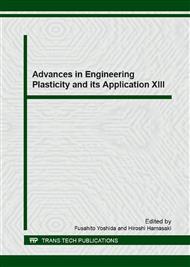p.110
p.116
p.122
p.127
p.132
p.138
p.143
p.149
p.156
Rate-Dependent Material Parameters of the Combined Isotropic/Kinematic Hardening Model for the TRIP980 Steel Sheet
Abstract:
This paper is concerned with rate-dependent hardening behaviors of the TRIP980 steel sheet. In sheet metal forming, sheet metals experiences complicated loading at various strain rates. In order to predict deformed shape in sheet metal forming, accurate material properties and an appropriate constitutive model in numerical simulation are important to consider reverse loading and various strain rates simultaneously.This paper deals with rate-dependent material parameters of the isotropic/kinematic hardening model. Tension/compression tests of the TRIP980 steel sheet are performed with a newly developed experimental technique at various strain rates ranging from 0.001 to 100 s−1. Tension/compression hardening curves of the TRIP980 steel sheet are approximated by the Chun et al model at each strain rate condition respectively. From acquired material parameters, rate dependencies of tension/compression hardening behaviors are investigated.
Info:
Periodical:
Pages:
132-137
Citation:
Online since:
December 2016
Authors:
Price:
Сopyright:
© 2017 Trans Tech Publications Ltd. All Rights Reserved
Share:
Citation:


